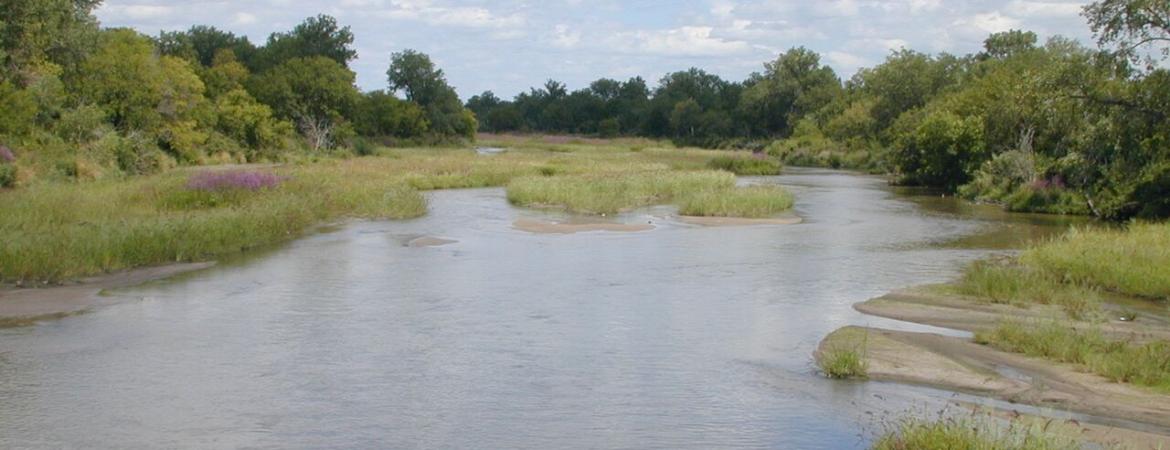Water
Water
Farmers, ranchers, urban residents, industries, recreationists, livestock and wildlife all depend on Nebraska's most precious natural resource – water. Water is vital to life. Thanks largely to the High Plains Aquifer, Nebraska has more groundwater than any other state. Two thirds of the High Plains Aquifer’s total water storage is in Nebraska. The Ogallala Aquifer is part of the High Plains Aquifer that spans eight states and covers 175,000 square miles. If poured over the surface of the state, the water in those aquifers would have a depth of 37.9 feet (11.6 meters).
Above ground, the state is laced with nearly 80,000 miles of flowing rivers and streams. Nebraska's major river basins include the Missouri, Platte, Niobrara, Loup, Republican, Elkhorn, Nemaha and Blue.
Though it is plentiful and usable, Nebraska's water is neither infinite nor immune from pollution. Irrigators, cities and villages, industries and wildlife all compete for this precious resource. Contamination may come from sediment, farming chemicals, urban runoff and industrial sources.
Natural Resources Districts (NRDs) have local leadership responsibilities for protecting groundwater from overuse and pollution. Each district also has a plan to protect groundwater. State law has given districts a variety of regulatory tools to deal with contamination, shortages or user conflicts.
NRDs encourage stewardship by providing financial assistance to landowners for irrigation water management and best management practices to protect water. NRDs are not just water protectors, in some cases they are providers. A number of NRDs operate drinking water systems for rural customers and small communities.
Nebraska Water Facts (2024)
NRD Groundwater Management
- NRD Groundwater Quantity and Quality Regulations (updated Jan. 2024)
- NRD Groundwater Management Summary (updated Jan. 2023)
- Nebraska Groundwater Irrigated Acres Summary (updated 2022)
Perkins County Canal Project
- Perkins County Canal Fact Sheet (Nov. 2022)
- Perkins County Canal Fact Sheet (Dec. 2022)
- NDNR Fact Sheet
- Video: South Platte River Compact Fundamentals and Connections
- Video: Visual Tour of South Platte Return Flow Conditions
- Video: How Colorado is Currently using Return Flows
- Video: Perkins County Canal Project Operations and Overview
NRD Water Projects
- NCORPE - (Nebraska Cooperative Republican Platte Enhancement Project)
- NCORPE Public Access Program - Hunting Rules and Regulations, More Public Uses Expected In Future!
Groundwater Quality
Nebraska’s NRDs lead the nation in groundwater quality management by targeting areas with known non-point source contamination. Soil type and depth to water are the main factors in determining the vulnerability of groundwater. Best Managements Practices (BMPs) such as irrigation management and proper nitrogen/pesticide applications, are needed to prevent contaminant from entering Nebraska’s drinking water.
- How do Nitrates get into your Groundwater?
- Six Easy Ways to Prevent Nitrates from Entering Nebraska's Groundwater
- Nebraska Nitrate Working Groups
- UNL Nitrogen Tool - Calculate the amount of nitrogen fertilizer needed for farm fields (released December 2023)
Water Education
The Nebraska Watershed Aquifer Virtual Education System (WAVES) is devoted to Nebraskans who are:
- Engaged in water management processes
- Interested in how water moves through our watersheds and aquifers
- Looking for the latest water research stories
Private Well Reverse Osmosis Rebate Program
In 2022, the Nebraska Legislature passed LB1014. This bill took $4 million from the American Rescue Plan Act and allocated it to treating nitrate issues in Nebraska. Of that funding, $1.2 million has been dedicated to a Reverse Osmosis Rebate Program that is directed at private well owners. The general idea of the program is that any individual private drinking water well owner can test their water AND if the nitrate concentration comes back above 10 ppm, they might be eligible for up to $4,000 support to get a reverse osmosis system to treat their nitrate.
- NE Department of Environment and Energy Press Release Offering Free Nitrate Sample Kits (Nov. 29, 2023)
- NE Department of Environment and Energy Press Release on Program (Jan. 4, 2023)
- NE Department of Environment and Energy Program Guidelines
- Video on Applying for Reverse Osmosis Rebate (Dec. 28, 2022)
- UNL Water Extension Information about the Program (Jan. 6, 2023)
- Flatwater Free Press: Nitrate help in your area: Find your NRD, learn about its resources (Dec. 23, 2022)

